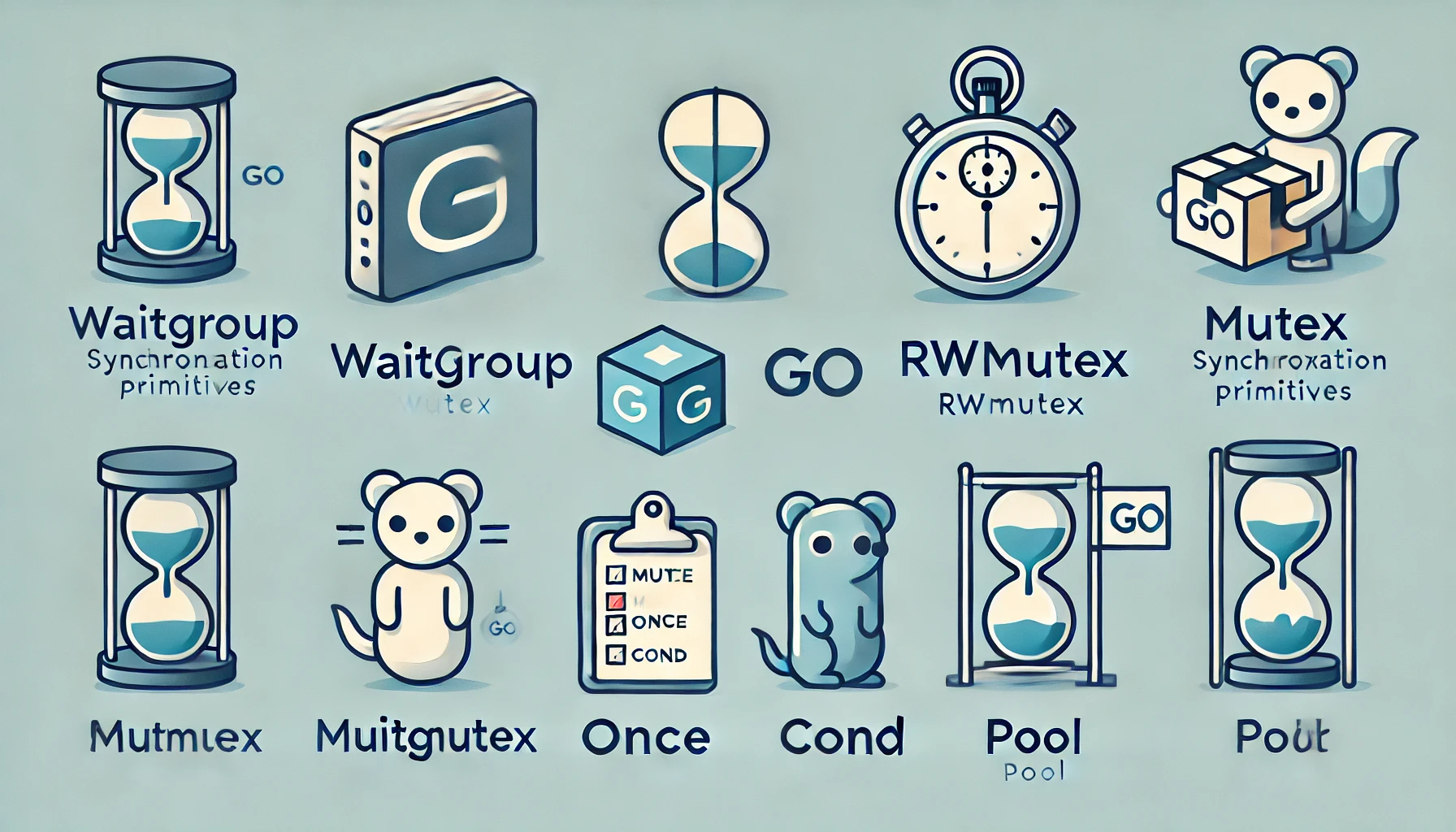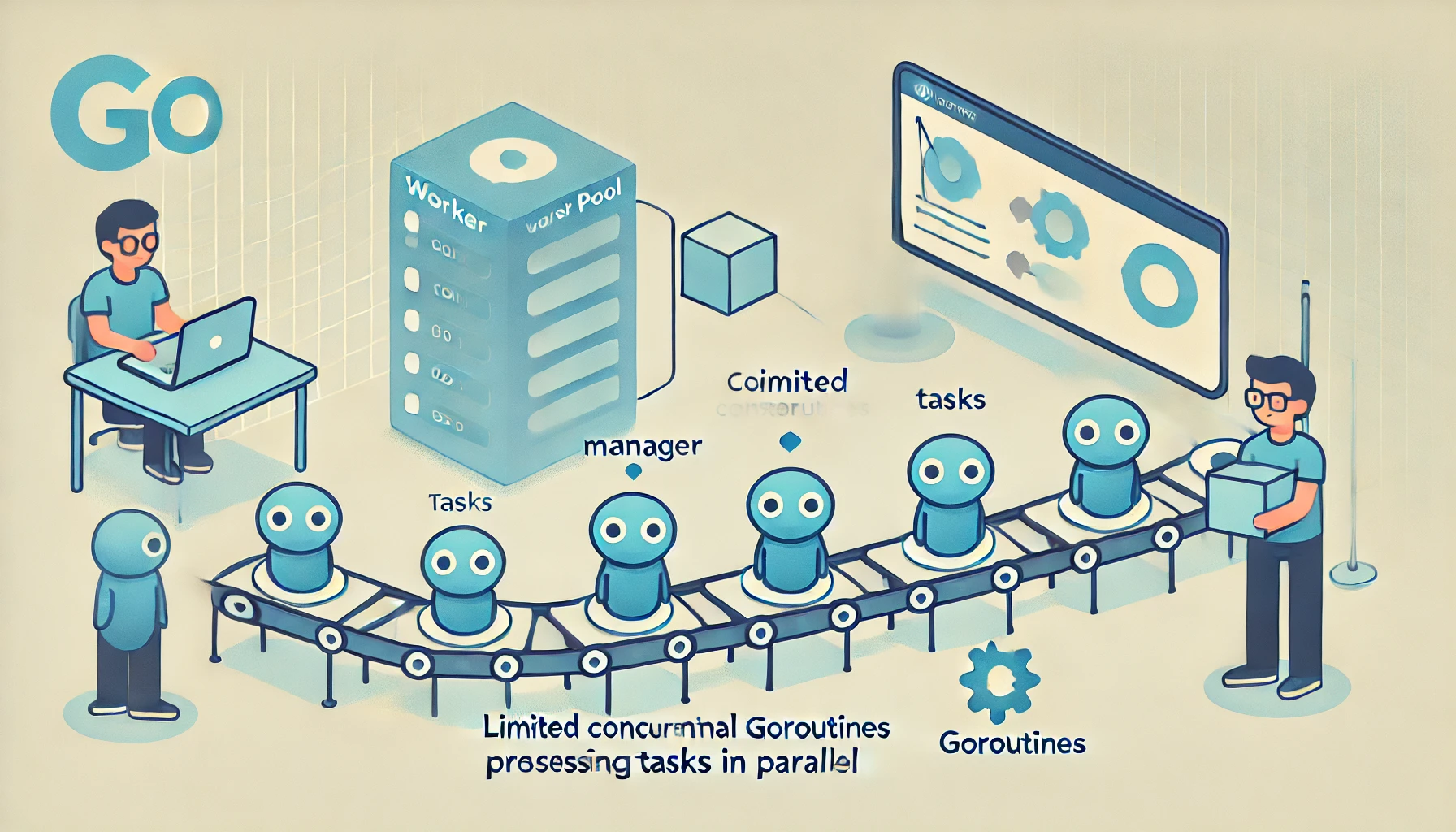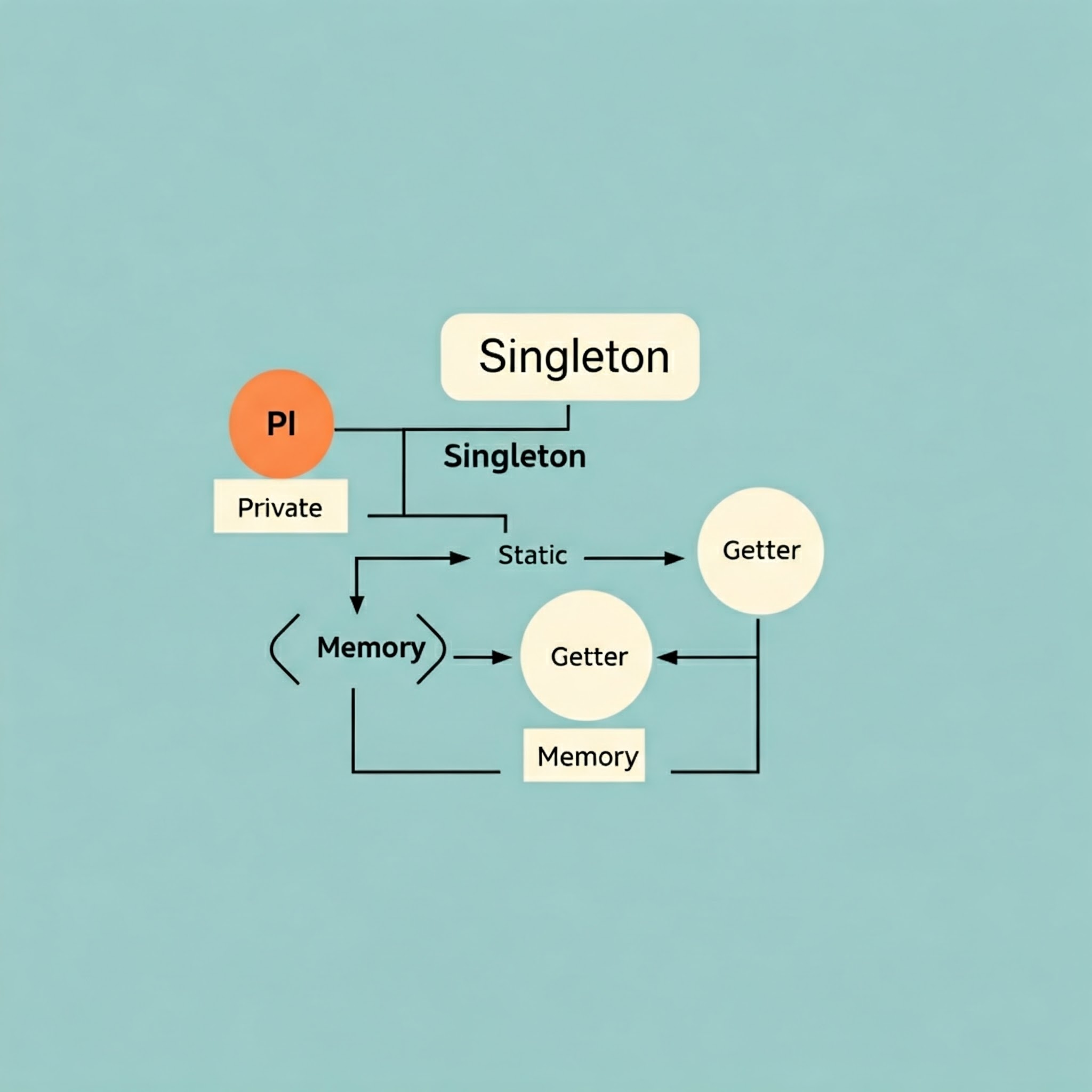· 6 min read
The sync package in Go
provides synchronization primitives to manage concurrent operations.

The sync package in Go provides synchronization primitives to manage concurrent operations. Here are the key functionalities with code examples:
1. WaitGroup
A WaitGroup waits for a collection of goroutines to finish.
package main
import (
"fmt"
"sync"
"time"
)
func worker(id int, wg *sync.WaitGroup) {
defer wg.Done() // Notify WaitGroup that this goroutine is done
fmt.Printf("Worker %d starting\n", id)
time.Sleep(time.Second)
fmt.Printf("Worker %d done\n", id)
}
func main() {
var wg sync.WaitGroup
for i := 1; i <= 3; i++ {
wg.Add(1) // Increment WaitGroup counter
go worker(i, &wg)
}
wg.Wait() // Wait for all goroutines to finish
fmt.Println("All workers done")
}2. Mutex
A Mutex ensures exclusive access to shared resources.
package main
import (
"fmt"
"sync"
)
var counter int
var mu sync.Mutex
func increment(wg *sync.WaitGroup) {
defer wg.Done()
mu.Lock() // Lock the mutex
counter++
mu.Unlock() // Unlock the mutex
}
func main() {
var wg sync.WaitGroup
for i := 0; i < 1000; i++ {
wg.Add(1)
go increment(&wg)
}
wg.Wait()
fmt.Println("Final counter value:", counter)
}3. RWMutex
A RWMutex allows multiple readers or one writer at a time.
package main
import (
"fmt"
"sync"
"time"
)
var (
data map[string]string
rwMu sync.RWMutex
)
func readData(key string, wg *sync.WaitGroup) {
defer wg.Done()
rwMu.RLock() // Lock for reading
value := data[key]
rwMu.RUnlock() // Unlock after reading
fmt.Println("Read:", key, value)
}
func writeData(key, value string, wg *sync.WaitGroup) {
defer wg.Done()
rwMu.Lock() // Lock for writing
data[key] = value
rwMu.Unlock() // Unlock after writing
fmt.Println("Write:", key, value)
}
func main() {
data = make(map[string]string)
var wg sync.WaitGroup
wg.Add(1)
go writeData("foo", "bar", &wg)
wg.Add(2)
go readData("foo", &wg)
go readData("foo", &wg)
wg.Wait()
}4. Once
Once ensures a function is executed only once, even across multiple goroutines.
package main
import (
"fmt"
"sync"
)
var (
once sync.Once
)
func initialize() {
fmt.Println("Initializing...")
}
func worker(wg *sync.WaitGroup) {
defer wg.Done()
once.Do(initialize) // Ensure initialize() is called only once
fmt.Println("Worker running")
}
func main() {
var wg sync.WaitGroup
for i := 0; i < 3; i++ {
wg.Add(1)
go worker(&wg)
}
wg.Wait()
}5. Cond
Cond is a condition variable used to signal between goroutines.
package main
import (
"fmt"
"sync"
"time"
)
var (
mu sync.Mutex
cond *sync.Cond
ready bool
)
func waitForReady() {
mu.Lock()
for !ready {
cond.Wait() // Wait for the condition to be signaled
}
fmt.Println("Ready!")
mu.Unlock()
}
func setReady() {
time.Sleep(time.Second)
mu.Lock()
ready = true
cond.Signal() // Signal that the condition is met
mu.Unlock()
}
func main() {
cond = sync.NewCond(&mu)
go waitForReady()
go setReady()
time.Sleep(2 * time.Second)
}6. Pool
Pool manages a pool of reusable objects to reduce allocation overhead.
package main
import (
"fmt"
"sync"
)
type Resource struct {
ID int
}
func main() {
var pool = sync.Pool{
New: func() interface{} {
return &Resource{ID: 0}
},
}
// Get a resource from the pool
resource := pool.Get().(*Resource)
fmt.Println("Resource ID:", resource.ID)
// Put the resource back into the pool
pool.Put(resource)
// Get the same resource again
resource = pool.Get().(*Resource)
fmt.Println("Resource ID after reuse:", resource.ID)
}Summary of Key Functionalities:
- WaitGroup: Wait for goroutines to finish.
- Mutex: Ensure exclusive access to shared resources.
- RWMutex: Allow multiple readers or one writer.
- Once: Execute a function exactly once.
- Cond: Signal between goroutines based on conditions.
- Pool: Manage a pool of reusable objects.
These primitives are essential for writing safe and efficient concurrent Go programs.
If you want to dive even deeper into the sync package and explore additional functionalities or advanced use cases, here are more examples and explanations:
7. Map
sync.Map is a concurrent-safe map designed for use cases where keys are only written once but read many times.
package main
import (
"fmt"
"sync"
)
func main() {
var sm sync.Map
// Store values
sm.Store("foo", "bar")
sm.Store(42, 100)
// Load values
if value, ok := sm.Load("foo"); ok {
fmt.Println("foo:", value)
}
// Delete a key
sm.Delete(42)
// Range over the map
sm.Range(func(key, value interface{}) bool {
fmt.Println(key, ":", value)
return true // Continue iteration
})
}8. Atomic Operations
The sync/atomic package provides low-level atomic memory operations. These are useful for managing simple shared variables without locks.
package main
import (
"fmt"
"sync"
"sync/atomic"
)
func main() {
var counter int64
var wg sync.WaitGroup
for i := 0; i < 100; i++ {
wg.Add(1)
go func() {
defer wg.Done()
atomic.AddInt64(&counter, 1) // Atomic increment
}()
}
wg.Wait()
fmt.Println("Counter:", atomic.LoadInt64(&counter)) // Atomic read
}9. Semaphore Pattern Using Channels
While Go doesn’t have a built-in semaphore, you can implement one using buffered channels.
package main
import (
"fmt"
"sync"
"time"
)
func worker(id int, sem chan struct{}, wg *sync.WaitGroup) {
defer wg.Done()
sem <- struct{}{} // Acquire semaphore
fmt.Printf("Worker %d started\n", id)
time.Sleep(time.Second)
fmt.Printf("Worker %d done\n", id)
<-sem // Release semaphore
}
func main() {
var wg sync.WaitGroup
sem := make(chan struct{}, 3) // Semaphore with 3 slots
for i := 1; i <= 10; i++ {
wg.Add(1)
go worker(i, sem, &wg)
}
wg.Wait()
}10. Custom Synchronization with Channels
Channels can be used to build custom synchronization mechanisms.
package main
import (
"fmt"
"sync"
"time"
)
func worker(id int, done chan bool, wg *sync.WaitGroup) {
defer wg.Done()
fmt.Printf("Worker %d started\n", id)
time.Sleep(time.Second)
fmt.Printf("Worker %d done\n", id)
done <- true // Signal completion
}
func main() {
var wg sync.WaitGroup
done := make(chan bool, 3)
for i := 1; i <= 3; i++ {
wg.Add(1)
go worker(i, done, &wg)
}
// Wait for all workers to signal completion
for i := 0; i < 3; i++ {
<-done
}
wg.Wait()
fmt.Println("All workers done")
}11. Error Groups
The errgroup package (from golang.org/x/sync/errgroup) is useful for managing groups of goroutines that can return errors.
package main
import (
"fmt"
"golang.org/x/sync/errgroup"
"time"
)
func worker(id int) error {
fmt.Printf("Worker %d started\n", id)
time.Sleep(time.Second)
if id == 2 {
return fmt.Errorf("worker %d failed", id)
}
fmt.Printf("Worker %d done\n", id)
return nil
}
func main() {
var g errgroup.Group
for i := 1; i <= 3; i++ {
id := i
g.Go(func() error {
return worker(id)
})
}
if err := g.Wait(); err != nil {
fmt.Println("Error:", err)
} else {
fmt.Println("All workers done successfully")
}
}12. SingleFlight
The singleflight package (from golang.org/x/sync/singleflight) prevents duplicate function calls for the same key.
package main
import (
"fmt"
"golang.org/x/sync/singleflight"
"sync"
"time"
)
func fetchData(key string) (string, error) {
fmt.Println("Fetching data for:", key)
time.Sleep(time.Second)
return "data for " + key, nil
}
func main() {
var g singleflight.Group
var wg sync.WaitGroup
for i := 0; i < 5; i++ {
wg.Add(1)
go func() {
defer wg.Done()
result, err, _ := g.Do("key", func() (interface{}, error) {
return fetchData("key")
})
if err != nil {
fmt.Println("Error:", err)
} else {
fmt.Println("Result:", result)
}
}()
}
wg.Wait()
}13. Context with Goroutines
Use context to manage the lifecycle of goroutines.
package main
import (
"context"
"fmt"
"sync"
"time"
)
func worker(ctx context.Context, wg *sync.WaitGroup) {
defer wg.Done()
for {
select {
case <-ctx.Done():
fmt.Println("Worker stopped:", ctx.Err())
return
default:
fmt.Println("Working...")
time.Sleep(500 * time.Millisecond)
}
}
}
func main() {
ctx, cancel := context.WithTimeout(context.Background(), 2*time.Second)
defer cancel()
var wg sync.WaitGroup
wg.Add(1)
go worker(ctx, &wg)
wg.Wait()
fmt.Println("Main done")
}Summary of Advanced Functionalities:
- sync.Map: Concurrent-safe map for read-heavy workloads.
- Atomic Operations: Low-level atomic memory operations.
- Semaphore Pattern: Implemented using buffered channels.
- Custom Synchronization: Using channels for signaling.
- Error Groups: Manage goroutines that can return errors.
- SingleFlight: Deduplicate function calls.
- Context: Manage goroutine lifecycle and cancellation.
These advanced techniques will help you write more robust and efficient concurrent Go programs.



